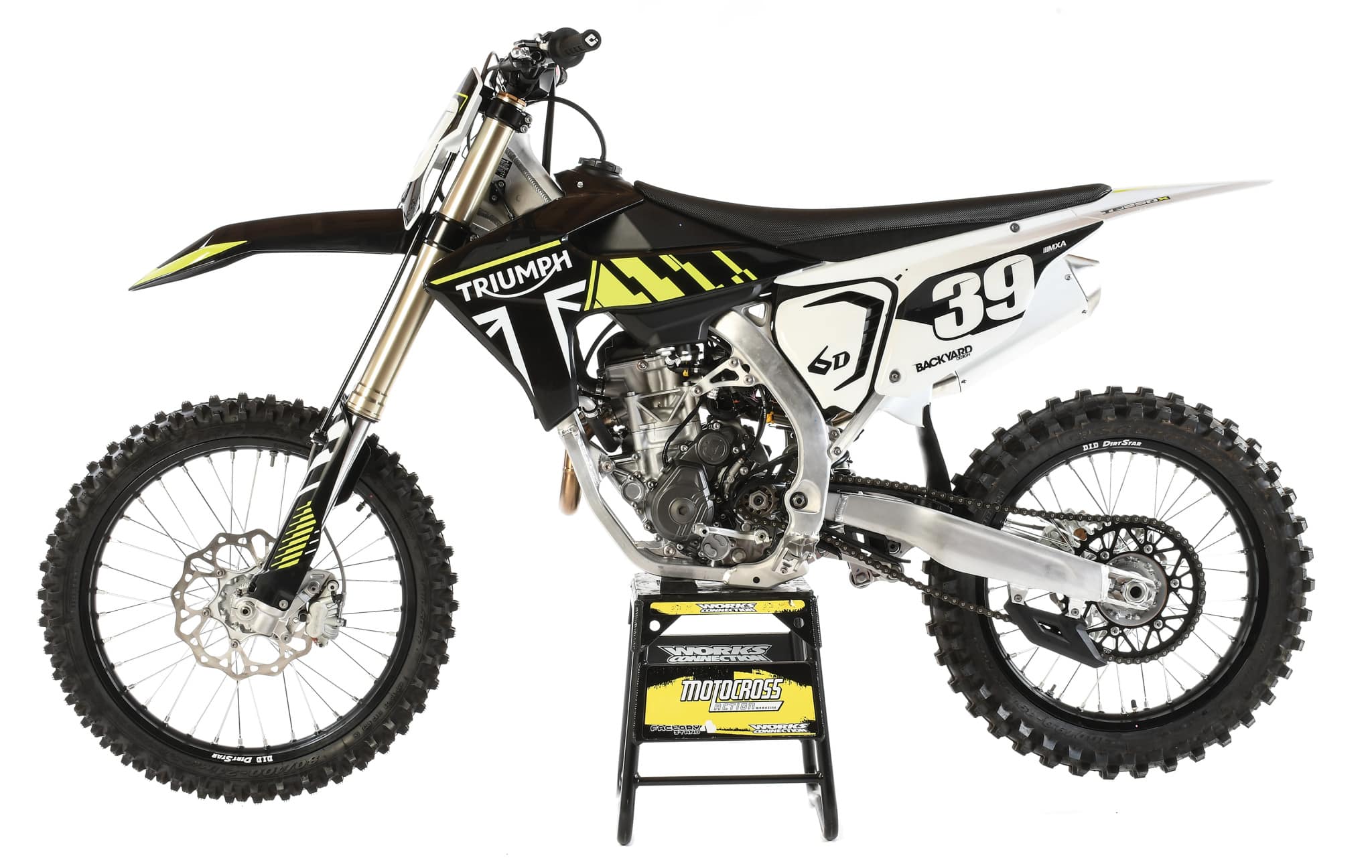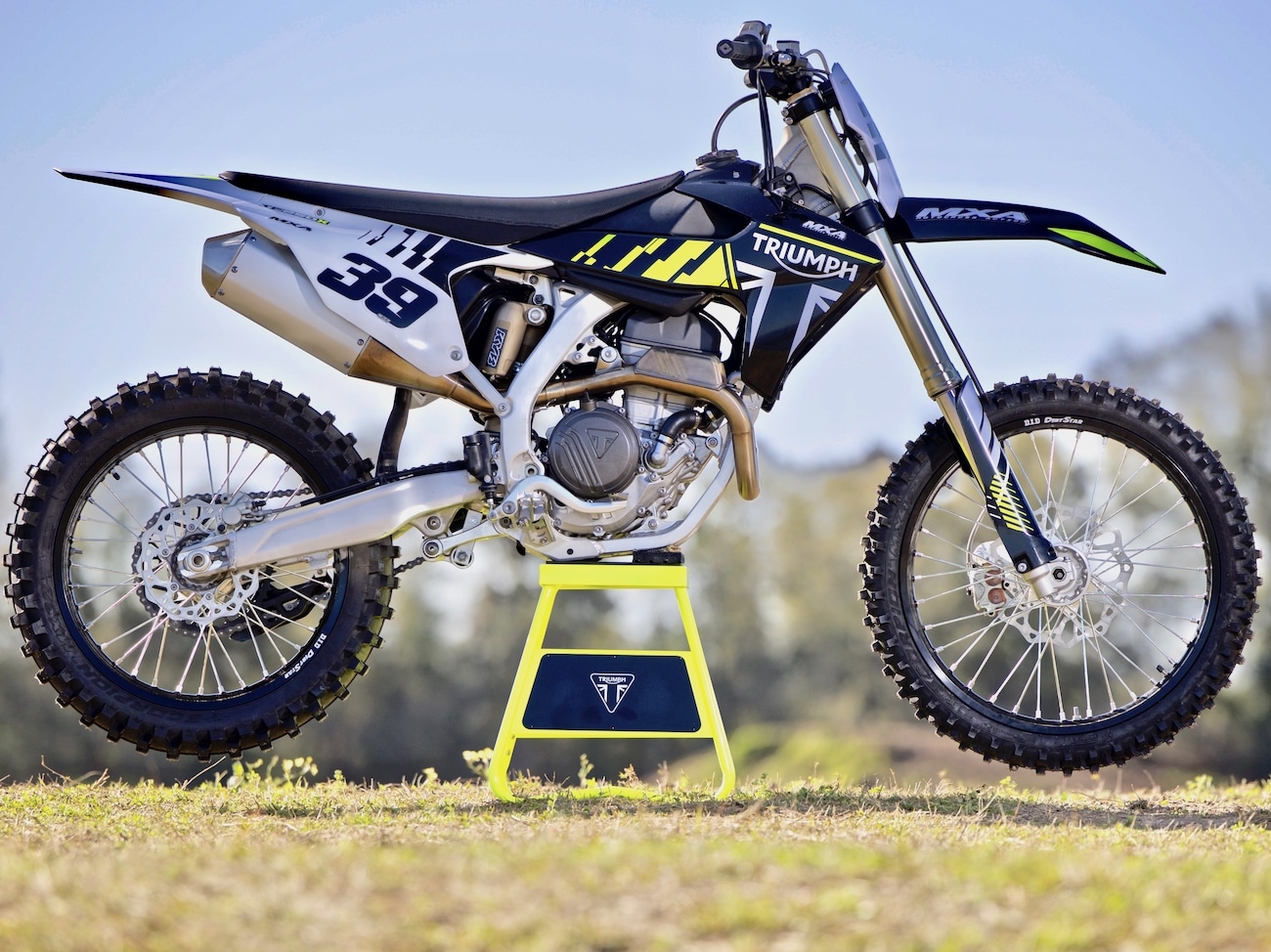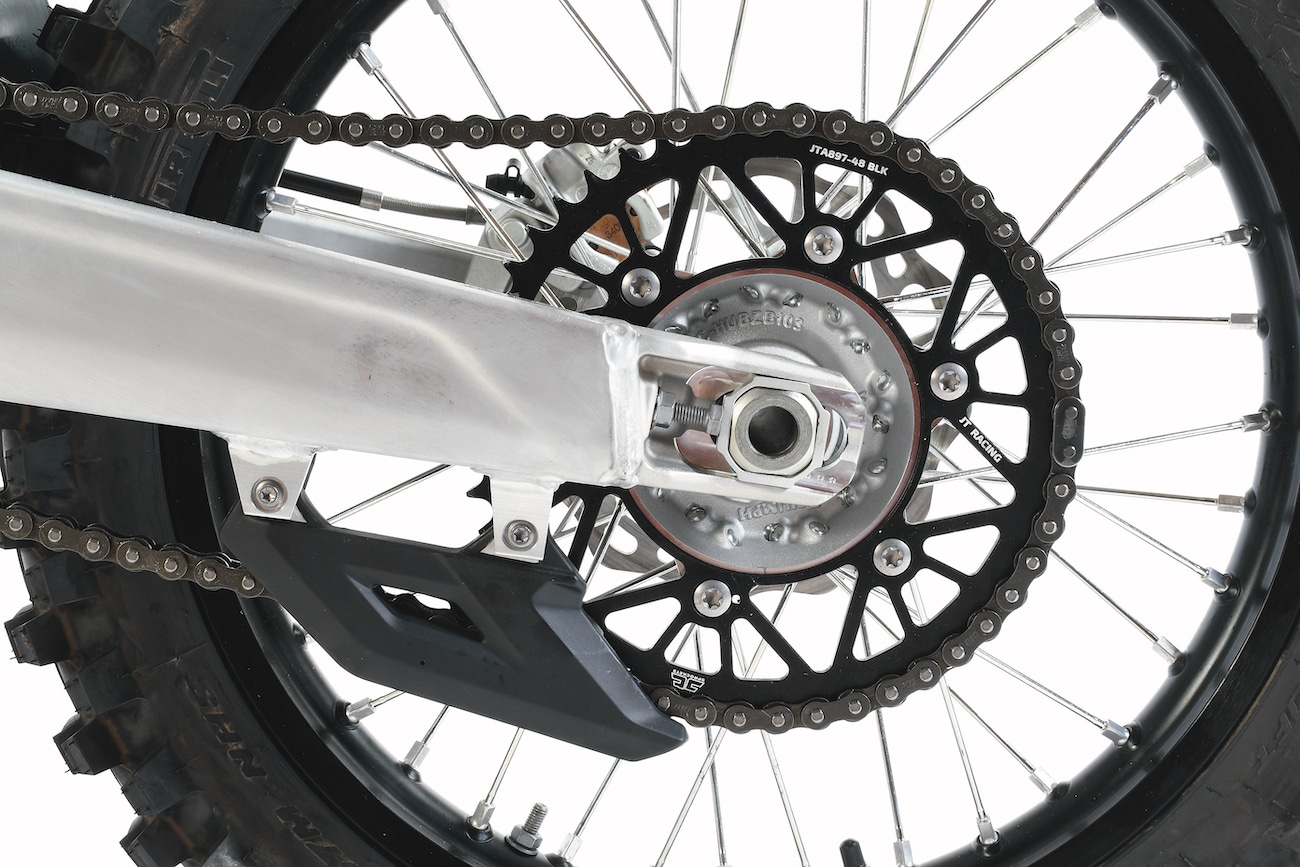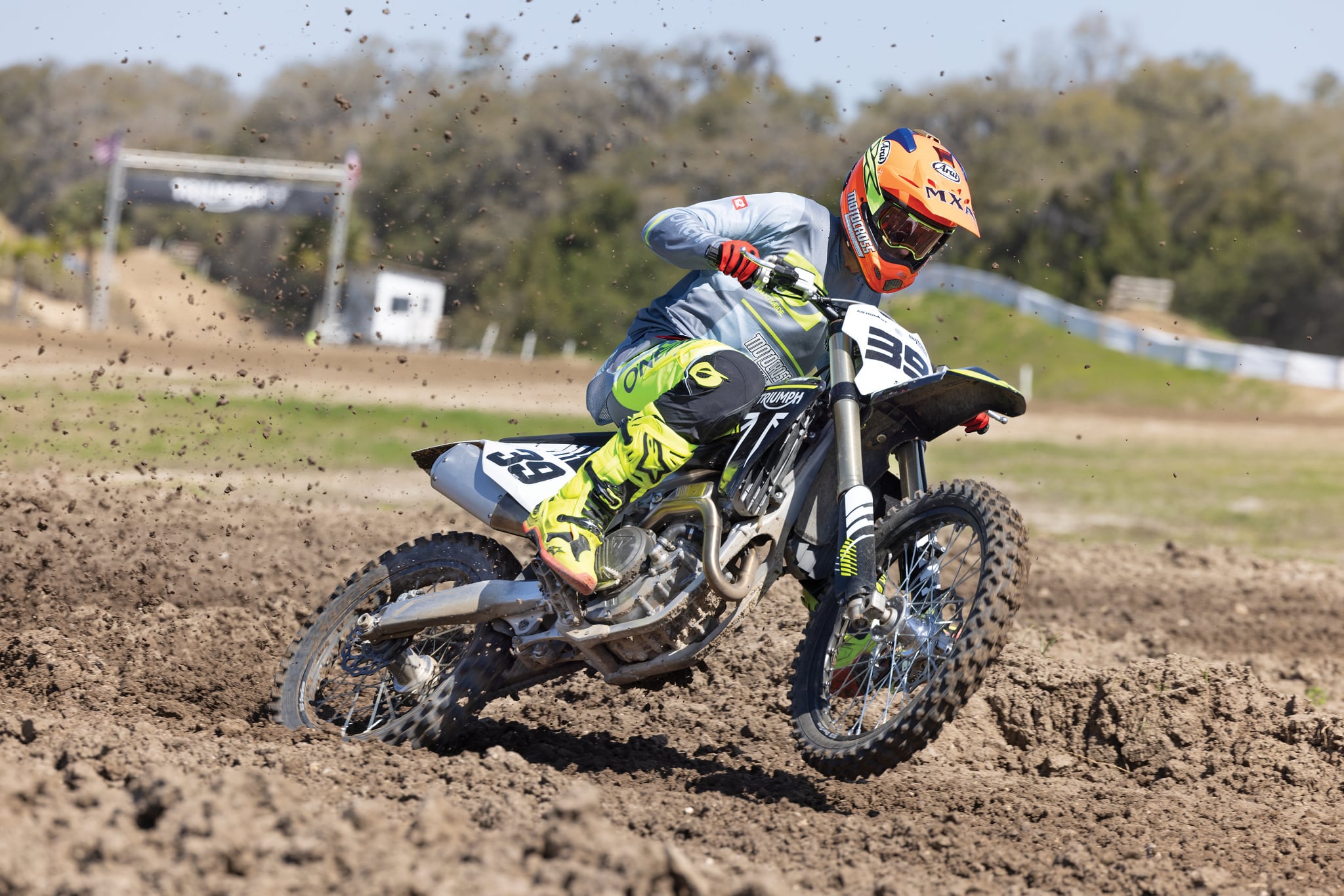MXA RACE TEST: THE REAL TEST OF THE 2024 TRIUMPH TF250-X
 THE GEAR: Jersey: O’Neal Hardwear, Pants: O’Neal Hardwear, Helmet: Arai VX-Pro4, Goggles: EKS Brand Lucid, Boots: Alpinestars Tech 10.
THE GEAR: Jersey: O’Neal Hardwear, Pants: O’Neal Hardwear, Helmet: Arai VX-Pro4, Goggles: EKS Brand Lucid, Boots: Alpinestars Tech 10.
Q: FIRST AND FOREMOST, IS THE TRIUMPH TF250-X ANOTHER RE-BRANDED KTM?
A: This question gets asked a lot, and for good reason. Truth is, the Triumph TF250-X is in no way, shape or form a re-branded KTM. But, there are some similarities, as Triumph has specifically copied the Austrians in certain areas on the bike. The engine cases and bolt pattern look very similar to the KTM 250SX-F, the engine’s bore and stroke are the same as the 2022-and-prior 250SX-F models, and it has a Belleville washer spring in the clutch. Triumph and KTM are the only manufacturers with quick-shift modes in motocross, and a lot of the components are the same as KTM (i.e., Brembo brakes/hydraulic clutch, Twin Air filter, ProTaper bars [like Husky] and ODI lock-on grips). The Triumph even has the same rubber ties on the handlebars as KTM, which Kawasaki was smart to copy in 2024. The rear sprocket bolt pattern is the same as the Austrian brands, but the KTM wheels won’t fit on the Triumph.
In truth, the Triumph has some heavy inspiration from the other brands, but it’s still a unique machine. Although Triumph has a rich history spanning back to the very beginning of motocross as we know it, they only made one motocross model before (and it was a rebranded BSA). Fast-forward to 2024 and Triumph has made an official entrance into the motocross industry at a point in time where they can test other brands and take what they like and implement it on their bike.
 We love how the TF250-X handles.
We love how the TF250-X handles.
Q: WHY DID TRIUMPH CHOOSE 2024 TO ENTER THE WORLD OF MOTOCROSS?
A: The Triumph TF250-X is the culmination of a five-year project that started back on May 10, 2019. Rod Lopusnak, the GM of Triumph North America, took the owner of Triumph, John Bloor, and his son, Nick, to the Las Vegas Supercross, a practice day at Glen Helen, and a practice day at Pala Raceway. The average Triumph rider is 47 years old, while KTM’s average rider age is 37. Triumph is basically using the same business model as KTM, only it’s flipped upside down. KTM started with off-road bikes, making everything from a 50 to a 450, and in recent years they’ve ramped up their street and adventure bike model ranges to keep that customer on KTM longer and reach an older audience. Triumph is already popular in the street market, and they want to get into the off-road world to find a younger audience and expand their market.
Triumph plans to introduce a TF450-X soon, and eventually they want to have a full line of mini-bikes and off-road models as well. On page 60, Milt Reimer explains how his success in the snow market helped finance his early years of introducing FXR to the motocross world. In the same fashion, Triumph’s street bike sales have funded the last five years of development for their new motocross bikes. Triumph isn’t a pop-up brand jumping into motocross without any experience; they have resources and the ability to make high-quality bikes from the get-go. Triumph’s engines and frames are built at their facility in Thailand.
 The TF250-X comes with smaller 1.85 rear rim (instead of the typical 2.15). This is so they can mount a skinny Pirelli MX32 100/90-19 rear tire. Not a plus, except in the weight department.
The TF250-X comes with smaller 1.85 rear rim (instead of the typical 2.15). This is so they can mount a skinny Pirelli MX32 100/90-19 rear tire. Not a plus, except in the weight department.
HOW DOES THE 2024 TRIUMPH TF250-X RUN ON THE TRACK?
A: Our test riders were impressed with the bottom-end grunt. Off the crack of the throttle, it is snappy and exciting, which is appreciated in the 250 class. Unfortunately, the crack-of-the-throttle snap was the highlight of the Triumph’s engine. It feels like the TF250-X engineers ran out of time when it came to finalizing the mapping. If you hit the gas too hard, you’ll find the TF250-X has a bog down low. At first, it was concerning, but the more we rode the TF250-X, the more we learned about how to work around it. It wasn’t an electrical problem, but a mapping problem. Depending on how you ride a 250 four-stroke, you might not notice the bog. Frankly, not all of our testers felt it on the track; some never felt it at all, some only felt it in the pits, and the most experienced riders felt it often on the track.
 The gearing and powerband do not work well together. More top-end power would help make the tall 48-tooth gearing pull harder.
The gearing and powerband do not work well together. More top-end power would help make the tall 48-tooth gearing pull harder.
Once you start shifting, you’ll hit your second problem. The gearbox is notchy, and it puts up a fight on grabbing the next gear. As we type this, our test riders are still trying to grab third. The KTM Quick Shift mode is not overly popular with our test riders when riding the Austrian bikes, but it is highly beneficial on this British one. Just like on a street bike, the Quick Shift mode cuts the ignition instantly as your foot applies pressure to the lever, allowing the transmission to jump to the next gear without any gear lash. This helped alleviate Triumph’s notchy shifting troubles, but it wasn’t foolproof. If you accidentally nudged the Quickshifter but didn’t lift your foot all the way in to grab the next gear, then the Quick Shift would disengage until you jammed it into the next gear, no matter how long you waited to try again. Similar to the bog on the bottom end, it isn’t the end of the world if you understand what it’s doing, but it took a few motos to figure it out.
Once you figure out the shifting, the power is very flat. It ramps up quickly, but then the excitement goes away and you quickly find yourself on the rev limiter looking for more power. When we saw that the TF250-X comes stock with a 13/48 gear ratio, we expected it to be lackluster down low and pull for a long way, but that wasn’t the case. Even with the 48-tooth sprocket on the rear, it has a great snap down low, but doesn’t pull as long as we’d like. Compared to the KTM 250SX-F with a 13/51 gear ratio the Triumph falls flat, while the KTM loves to be ridden high in the rpm range, and it keeps making power. Based on the gear ratios, you’d think it would be the opposite.
 The Triumph TF250-X hit 42.67 horsepower (KTM hits44.98) and 19.65 pound-feet of torque (KTM hits 20.81).
The Triumph TF250-X hit 42.67 horsepower (KTM hits44.98) and 19.65 pound-feet of torque (KTM hits 20.81).
Q: HOW DOES THE 2024 TRIUMPH TF250-X RUN ON THE DYNO?
A: The Triumph TF250-X power curve is rough. It starts strong off the crack of the throttle, but the strong initial punch is followed by a bog and a surge, and another dip and surge. Compared to the rest of the 250 class, the TF250-X has potential, but the mapping doesn’t do this engine justice. We put the TF250-X up against last year’s “250 Shootout” winner, the KTM 250SX-F, and it was 2.3-horsepower slower at peak and had just under 1 pound-foot of torque less at peak.
The Triumph TF250-X hit 42.67 horsepower (KTM hit 44.98) and 19.65 pound-feet of torque (KTM hit 20.81). At 8000 rpm, the KTM was 2 horsepower stronger; at 9000 rpm, it was 1-1/2 horsepower faster; at 10,000 rpm, it was 4 horsepower faster; at 11,000 rpm, it was over 3 horsepower more powerful; at 12,000, the KTM was 1-1/2 horsepower faster; and at 13,000, the KTM was 2 horses stronger than the Triumph. The KTM 250SX-F has a linear curve that climbs steadily all the way to sign-off, while the Triumph power delivery goes up and down like a roller coaster.
The Triumph TF250-X does come with two maps: map one (light off) and map two (light on). The bike is most aggressive with the light off, and it’s significantly stronger than map two in the midrange, even though the second map hits the same peak horsepower number with slightly less torque. Both power curves are rough and jagged.
Q: HOW DOES THE 2024 TRIUMPH TF250-X HANDLE?
A: The chassis is the strong point of this bike. The Triumph TF250-X handles great! The first impression was incredible. The Triumph TF250-X is nimble and easy to dive into ruts, but it’s not so nimble that you get head-shake on the fast straights. We always say that Hondas are best for throwing whips, but it’s not because they’ve always been the lightest bikes around. Honda’s engine layout and position make them feel lighter mid-air and give experienced riders extra confidence for throwing style off the jumps. Like the Honda CRF250, the Triumph TF250X is a whipping machine. In the hands of the right rider, it likes to have fun.
Every year for almost two decades we’ve praised Yamaha’s two-stroke lineup for their comfortable chassis and great suspension, and Triumph took a page out of Yamaha’s playbook when it came to the frame. Yamaha’s central-backbone aluminum frame was introduced on their two-strokes (and it remains today). In 2009, Yamaha came out with their all-new backward-four-stroke engines and changed from the central-backbone frame to the perimeter frame (with aluminum spars that wrap around the fuel tank). KTM also uses a central-backbone frame, but theirs are made out of steel. The 2024 Triumph TF250-X comes with a central-backbone aluminum frame and Kayaba suspension with AOSS spring fork internals.
 The TF250-X engine has a 78mm bore and a 52.3mm stroke, the same as the 2022 and prior model KTM 250SXF.
The TF250-X engine has a 78mm bore and a 52.3mm stroke, the same as the 2022 and prior model KTM 250SXF.
Q: HOW IS THE 2024 TRIUMPH TF250-X SUSPENSION?
A: The stock suspension is respectable for a first-year model. Manufacturers with much more experience and R&D time have struggled to make their suspension work this well out of the box. No, it’s not a magic setting, but it’s a great start for the TF250-X. Front to rear, the bike is balanced and doesn’t require any crazy setting changes to get comfortable. For an average novice/intermediate rider in the 155–175-pound range, the stock suspension is great.
Even for our pro riders, the TF250-X corners nicely, giving them confidence in the ruts. However, the shock did blow through the stroke on hard landings or G-outs. On tracks with more traction, we stiffened up the rear shock by going in on the low-speed compression clicker and slowing down the rebound.
Q: HOW ARE THE TRIUMPH’S ERGONOMICS?
A: The “rider triangle” refers to the geometry of the footpegs, seat and handlebar position. Right away, you can tell that Triumph did their homework, because all of our test riders appreciated it and nobody complained about feeling cramped or awkward in the cockpit. The seat has a nice shape as well, and it’s plenty thick, offering extra cushion that is missed on the late-model Honda and Yamaha models.
A few of our test riders noted their appreciation for the footpegs. They’re sharp and are slightly angled upward, which helps you stay locked into the bike, gripping with your legs. The side panels also create a nice contact patch for gripping the bike, and the shrouds are long enough that you don’t catch your boots on the ends when riding through deep ruts. However, while on the topic of gripping the bike, we should note that the oil cap is in a vulnerable area. It’s in about the same spot as KTM’s plastic tool-less oil-cap screw, and we recommend switching the stock cap out for a Works Connection oil cap that your boot won’t be able to knock loose.
When it comes to fit and finish, you really can tell the Triumph TF250-X was thoughtfully constructed. As die-hard motocrossers, it’s easy to forget that Triumph is already a well-established, high-quality motorcycle brand in the street and scrambler world, but it makes sense when you start looking at the details of the TF250-X. For the last few years, KTM has led the way in the fit-and-finish department, and one example of that is how they go the extra mile to ensure each hose and cable are routed neatly, and secured with rubber ties rather than coming from the factory with cables secured onto the bike with zip-ties. The hour meter is also mounted neatly into the backside of the front number plate. The airbox is another area where Triumph borrowed KTM’s design. It comes with a Twin Air filter that snaps into place, and the airbox cover is also tool-less as well. The Brembo brakes use steel-braided lines, and the bike comes stock with ProTaper ACF handlebars and ODI lock-on grips.
They went the extra mile to make the TF250-X as premium as possible. They also worked hard to make it lightweight, and they did an incredible job. At 221 pounds, it’s slightly heavier than the Honda CRF250 as the lightest bike in the class. One complaint, though: they shaved some weight by switching out the standard hex-head bolts for Torx bolts that are botton. This was a mistake, because you can’t turn them with a 8mm or 10mm T-handle. You need a tTorz wrench on almost every bolt on the bike. We’ve heard they are changing this for the 2025 model.
 The Triumph pulls hard off the bottom end, but the power runs flat on top.
The Triumph pulls hard off the bottom end, but the power runs flat on top.
Q: WHAT DID WE HATE?
A: The hate list:
(1) Buttons. There’s nothing sleek about the map buttons. It’s like an obnoxiously big video-game controller on the bars.
(2) Plastics. We understand Triumph felt the need to stick with their black/silver street bike theme, but black plastics don’t clean up very well after a couple of rides.
(3) Wheel. The rear wheel comes with a 1.85 rim (instead of 2.15) and a Pirelli MX32 100/90-19 rear tire. It’s good for saving weight, not for grabbing traction.
(4) Mapping. The bog is not good and the power runs flat in the midrange.
(5) Transmission. It’s so notchy that Quick Shift is always necessary.
(6) Mud pack. The footpegs get stuffed with mud easily. We recommend Acerbis’ rubber footpeg hinge covers.
(7) Bolts. We hate the Triumph’s Torx bolts. Yes, KTM uses Torx bolts, but their bolts can be turned by a Torx wrench or by an 8mm T-handle. We understand Triumph wants to shave weight, but we’d rather use our 8mm and 10mm T-handle.
Q: WHAT DID WE LIKE?
A: The like list:
(1) Concept. We’re glad Triumph entered the motocross world—the more, the merrier!
(2) Brakes. Triumph was smart to spec the best brakes around, Brembo.
(3) Weight. We love that the Triumph TF250-X weighs 221 pounds. It’s impressive for the first-year model to be so light.
(4) Belleville washer. Triumph isn’t the only OEM to take a page out of KTM’s book on this one.
(5) Vented airbox cover. We appreciate that it comes with vented and non-vented options.
(6) Sound. We must tip our hats to the racy vibrato of the TF250-X engine. Straight from the dealership, it sounds fast.
Q: WHAT DO WE REALLY THINK?
A: Overall, the Triumph TF250-X was better than expected for a first-year bike. During our first day of testing with Triumph on a pristine Gatorback track in Florida, we thought this bike could be in the fight for winning MXA’s “2024 250 Shootout.” However, in Florida, we didn’t have any other bikes to compare it to. As usual, the “first date” butterflies wore off at Glen Helen, and the National track sobered us up to see the Triumph for what it is. It’s an amazing first-year bike with lots of growth potential. In the handling department, it’s the most fun bike to ride in stock trim. But, if you’re spending $10,000-plus on this 250, you need to know that the shifting is very notchy, the engine is fairly flat on top, and the mapping is a little rough.
Don’t buy the 2024 Triumph TF250-X if you’re looking to qualify for a Pro National or make it to Loretta Lynn’s in the B class. There are not enough hop-up parts available yet, and your local tuner probably doesn’t know enough about this bike to be able to build a modded TF250-X that’s on par with a race-ready YZ250F or 250SX-F. However, if you want a well-handling 250 four-stroke that stands out from the pack, you’ll love the first-generation Triumph TF250-X.







Comments are closed.